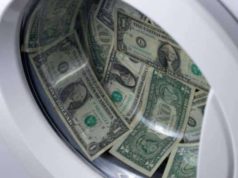
NATIONAL INDUSTRIAL RECOVERY ACT TEXT
What is the National Industrial Recovery Act of 1933?
Apart of FDR’s New Deal, the National Industrial Recovery Act of 1933 was an American statute that formally authorized the President of the United States to regulate industry and permit the formation of monopolies in an attempt to stimulate the economy and develop a national public works program. The National Industrial Recovery Act was implemented to get the nation out of the Great Depression—it was a fundamental act of the government to employ Americans and to bolster confidence in the domestic markets.
Formerly codified as 15 U.S.C section 703, the National Industrial Recovery Act (NIRA) was enacted in June of 1933 as part of President Franklin D. Roosevelt’s New Deal program. The Act was formally implemented by the Public Works Administration and the National Recovery Administration (NRA).
Background of the National Industrial Recovery Act of 1933:
The United States, through a series of poor banking practices and inept consumer investment strategies, fell victim to the Great Depression during October of 1929. The start of the Great Depression befuddled our nation’s leaders—President Hoover feared that an influx of government coercion or intervention would only perpetuate the market’s decline and ultimately destroy self-reliance. This laissez-faire approach was shared by the Federal government as a whole.
In response to the Great Depression, Hoover organized several voluntary measures with business entities and encouraged all levels of government to respond to damaged communities. Although hoover accelerated a number of federal building projects, the President’s efforts and policies had little effect on the nation’s economic recovery. Toward the latter stages of the Hoover administration, the President supported several legislative solutions to lift the country from the depression. Hoover’s final attempt to salvage the economy was the passage of the Emergency Relief and Construction Act (a piece of legislation that provided funds for public works programs) and the Reconstruction Finance Corporation (legislation that provided low-interest financing to American businesses). Herbert Hoover was ultimately defeated in the 1932 presidential election by Franklin D. Roosevelt.
The newly-appointed President convinced the masses that legislative activism and government intervention was needed to reverse the nation’s economic struggles. In his first hundred days in office, Roosevelt passed a number of bills designed to empower the banking system. Roosevelt passed the Emergency banking Act, the 1933 Banking Act and the Glass-Steagall Act (created the Federal Deposit Insurance Corporation FDIC).
Towards the end of Roosevelt’s first 100 hundred days in office, his administrative enacted the National Industrial Recovery act. A handful of Roosevelt’s advisors (most notably Raymomd Moley, Hugh Johnson, Bernard Branch, Jerome Frank, Rex Tugwell and Donald Richberg) believed that an unrestrained and regulated market perpetuated the Great Depression and that the federal government had a crucial role, through national planning, support of fair trade practices, the institution of worker rights and the democrization of the workplace, limited regulation and the fostering of trade associations to fix the broken economy. Roosevelt, in response, believed that government promotion of a self-organized initiative undertaken by trade associations was the least-intrusive yet most efficient method for obtaining economic improvement and national planning.
By May of 1933, two drafts emerged: a cautious bill composed by the Under Secretary of Commerce (John Dickinson) and an ambitious one, which focused on trade association. Following the inclusion of several business leaders and after much discussion, a two-part bill—the first section focused on cooperative action among business entities to provide national planning and achieve fair competition and a second that established a fully-functional national public works program—was submitted to the United States Congress on May 15th of 1933.
The House of Representatives passed the bill in seven days; however, the Senate struggled with fundamental aspects of the legislation, particularly its suspension of antitrust law. Prominent senators believed that a relaxation of the Sherman Antitrust Act would exacerbate economic inequalities and further widen the wealth gap. After a fervent defense of the bill, the Senate passed an amended legislation that included a provision to implement and uphold fair trade policies to help create a progressive standard for hours, wages and working conditions.
A House-Senate committee met throughout the night of June 9th and during the day of the 10th to reconcile the two versions of the bill—the committee approved the final version on the afternoon of the 10th. The Senate later approved the final bill on June 13th and Roosevelt signed it into law on June 16th of 1933.
Structure of the National Industrial Recovery Act:
The National Industrial Recovery Act has two major titles:
Title I of the National Industrial Recovery Act of 1933 was devoted to industrial recovery. This section empowered the President of the United States to establish an executive branch agency to implement the provisions of the act and provide sunset provisions that would nullify the act once the economy is stabilized. The crux of the first title was Section 3, which permitted industrial or trade associations to seek executive approval of fair competition and subsequently provided enforcement of these codes.
Title 1 also guaranteed the right of workers to band together to form unions and permitted the establishment of standards regarding working hours, minimum rates of pay and working conditions in industries explicitly covered by the codes. Title I of the National Industrial Recovery Act also authorized the regulation of national oil pipelines and transportation prices for all byproducts of said pipelines.
• Title II of the National Industrial Recovery Act formally established the Public Works Administration.
• Section 202 of Title II of the National industrial Recovery Act of 1933 outlines the types of public works which the newly-formed agency may build or seek funding for.
• Section 203 of Title II authorized the Public Works Administration to provide loans or grants to states and localities to promote employment as well as to use their eminent domain powers to size materials or land to engage in these public works.
• Section 204 of Title II openly provided $400 million in government funding for the construction of public bridges, roads, railroad crossings, paths, highways and other transportation projects.
• Section 208 of Title II authorized the executive branch to spend up to $25 million to purchase agricultural lands for the purpose of relocating farmers and individuals living in densely populated urban centers. When moved, these individuals were given supplies and funds to raise crops.
Following the enactment of the National Industry Recovery act, the Public Works Administration was formed to implement the provisions of the legislation.
Criticisms of the National Industrial Recovery Act:
From the time it was drafted as a two-part bill, the National Recovery act of 1933 reflected conflicting goals and as a result, suffered from widespread criticism. The big businesses who dominated the drafting of the NIRA’s code wanted guaranteed profits and insisted on protection for their renewed investment in the nation’s economy. In turn, congressional officers insisted on an open pricing model and saw the National Industrial Act as a means of implementing a fair and just system. Lastly, labor union representatives wanted a collective bargaining promise affirmed in the NIRA. These different wants ultimately yielded little effect—the codes raised prices which actually made the economy worse.
Because of its ineffectiveness, the National Industrial Recovery Act did not last long enough to fully implement its policies. In May of 1935, the United States Supreme Court invalidated the legislation’s compulsory-code system on the grounds that the National Industrial Recovery Act of 1933 improperly delegated powers to the executive branch of government.



























